The year was 1921, and while steamships were plentiful, it was still the era of the graceful sailing ships, especially perhaps in the Canadian maritime provinces, and northeastern US states.
At the time she was built in the spring of 1921, the graceful schooner Bluenose was intended as a working commercial fishing vessel and she proved to be a profitable ship too. But, she was also designed with racing in mind ,and those who sailed her knew she was something special. Her captain, Angus Walters had ordered a slight change from designer William J.Roue, raising the forward upper deck some18 inches (approx 45 cm) to give the crew more room. The self-taught designer was more used to creating recreational and racing boats and Bluenose was his first commercial contract.
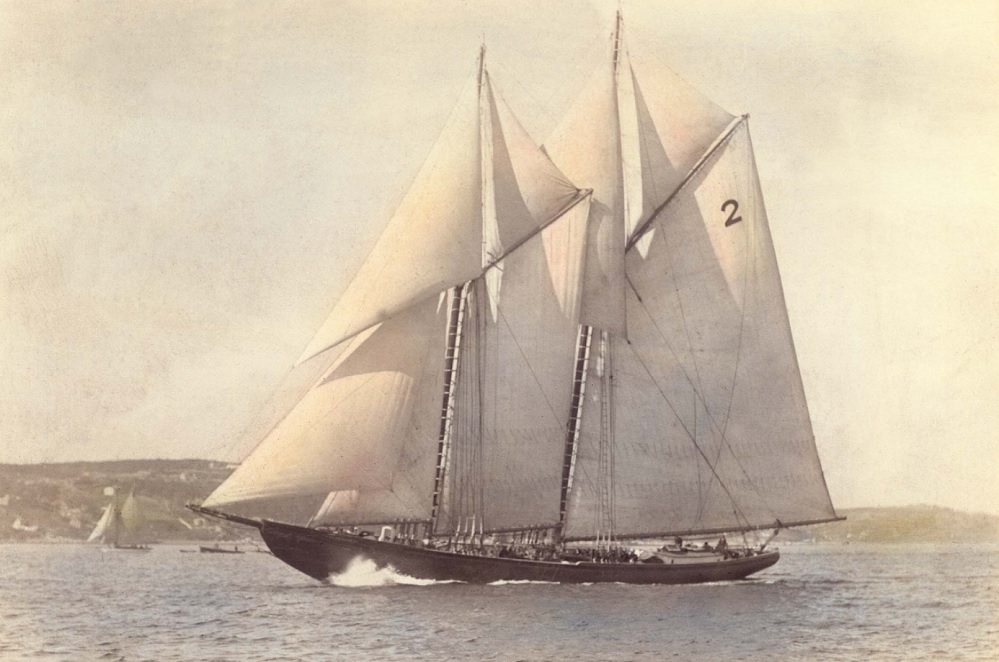
Bluenose at Halifax 1921
(WR MacAskill, hand colourized by Mrs Elva MacAskill- NS Archives)
East coast American and Canadian fisherman had been racing unofficially for years out to the fishing grounds in the North Atlantic and they often scoffed at the much hyped America’s Cup yacht race. That ocean race was for specially designed and hugely expensive fancy yachts, and was often delayed due to weather and seas the fisherman and their schooners would brave with no qualms.
Thus a year earlier in 1920, a Halifax, Nova Scotia newspaper owner and other investors offered a sailing challenge to Americans along with cash and a trophy. Not for the millionaire yachts and gentle weather of the America’s cup, this race would be between Canadian and American working fishing schooners to be called the International Fisherman’s Trophy.
At lengths of around 42 metres, with masts almost as high, the races were spectacular events especially in the strong winds and high seas.
An American schooner won that first race, but next year Bluenose was on the sea.
To compete, a ship had to complete at least one season fishing. Foretelling her future, the first trip out to the fishing ground saw Bluenose arriving hours ahead of the other ships though they had left at the same time. Bluenose also brought back a record haul of fish that year.
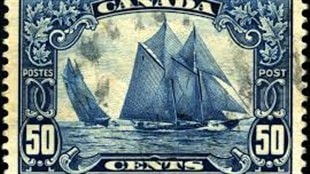
In October Bluenose beat all contenders for the right to challenge the American champion and won the 1921 race. She won again and 1922, and 1923 and every race she entered against American ships specially commissioned to try to beat her. They never could.
In 1933 the now famous Bluenose was to represent Canada at the Chicago “Century of Progress” World’s Fair where she was billed as “Queen of the North Atlantic Fishing Fleet”.
However commercial wooden ships don’t have a long life, and motorised vessels were now becoming the norm.
Still, even in 1938 when the now ageing and waterlogged fishing vessel was called out to race a final time she still edged out her American challenger in three out of five races.
But her days as a useful commercial ship were numbered.
With her proud record, the Halifax Herald newspaper had begun a campaign. to have the government take her over as a national symbol. Known to all Canadians by then, there was somewhat surprisingly no great interest in the wider Canadian public even though by that time she had been featured on a postage stamp, had been the subject of numerous national news articles and reports and from 1937 onward, featured on the Canadian 10-cent coin. She had also represented Canada at the Silver Jubilee of King George V in England in 1935.
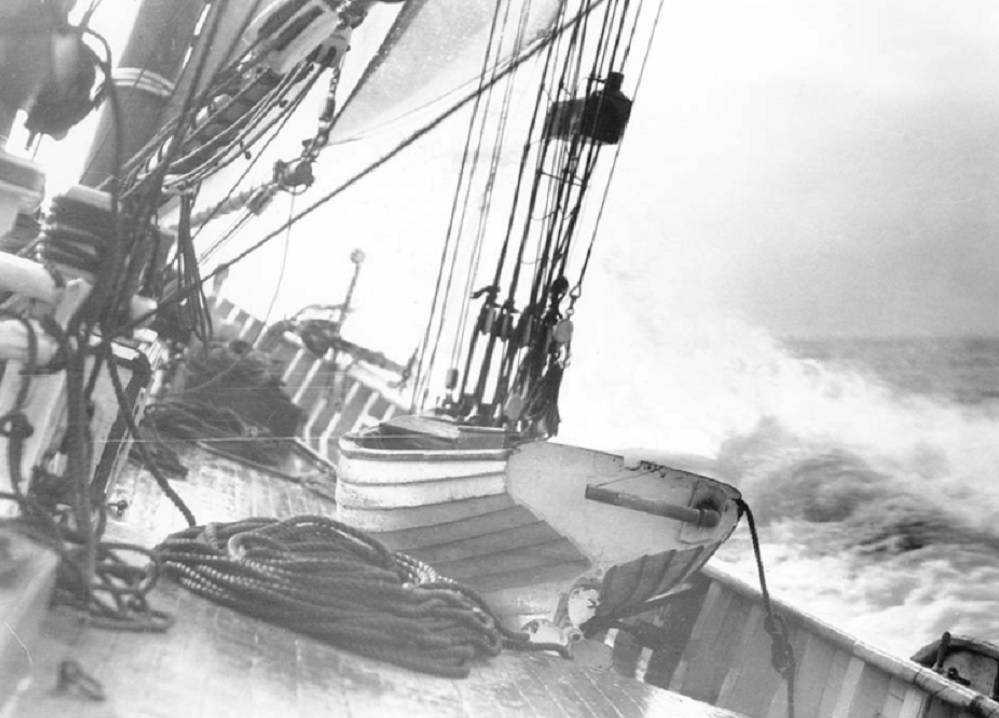
Unlike the rather delicate millionaire yachts of the America’s Cup, the working Grand Banks schooners were designed to cope with the open ocean. Bluenose in heavy seas. (WR MacAskill- NS Archives)
Alas the aging ship now had debts including that of $7,000 for diesel engines designed to try to keep her competitive with modern ships. Just before she was to be auctioned off, Captain Angus Walters put up his own money to keep his beloved vessel in Lunenburg.
But then war broke out and the North Atlantic became too dangerous. With the sea lanes closed the deep sea fishery collapsed. Bluenose remained tied up at the dock
By 1942, long out of work, obsolete and costing money, she had to be sold.
Canada’s grand lady now belonged to the West Indies Trading Company where she became an itinerant island trader sometimes carrying fruit and other supplies back and forth the U.S, along with occasional war materiel. One story had a U-Boat surfacing alongside her off Havana while she was allegedly carrying aviation fuel and dynamite. The German captain hailed the ship to ask her purpose, to which Bluenose replied she was simply a fishing boat. The U-Boat captain seemed satisfied and sailed off.
Ignoble end
It was on this day however, January 29, 1946 that the once grand ship was caught in a tropical storm and driven onto a reef at Isle a Vache, off the coast of Haiti. The crew escaped but the waves soon caused extensive damage and she slipped off the reef and sank. Her scattered remains are among those of many other ships and she has never been properly identified.
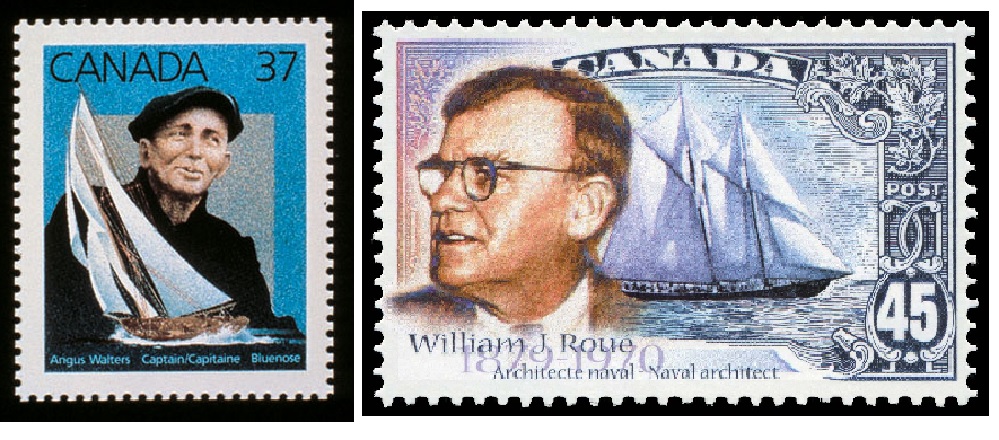
In addition to the 1929 Bluenose stamp, Captain Angus Walters was featured on a 1988 stamp, and designer W J Roue on a 1998 stamp. (Canada Post)
As for her challengers, the other magnificent Grand Banks schooners, they too ended badly. Esperanto sank near Sable Island in 1921. Columbia went down with all hands in the same area in 1927. The Henry S Ford struck a reef off Martin’s Point, Newfoundland in 1928. The Elsie sank in the Gulf of St Lawrence near St Pierre et Miquelon in 1935. Bluenose’ final challenger, the Gertrude L Thebaud was wrecked off the Venezuelan coast in 1948
In 1963, a replica, Bluenose II, using the original design was built and later became an international ambassador for the province of Nova Scotia, and Canada.
An entirely new Bluenose is expected to be ready to sail in 2014
2013 story on Bluenose II rebuild
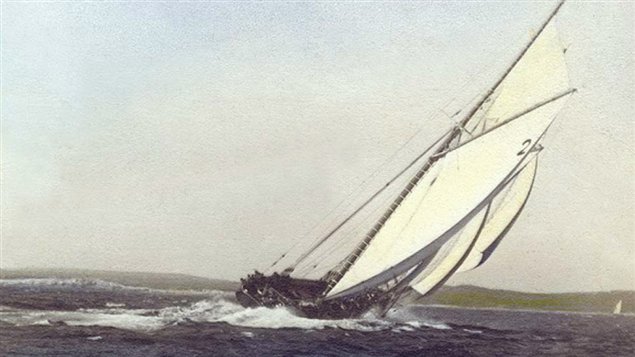






For reasons beyond our control, and for an undetermined period of time, our comment section is now closed. However, our social networks remain open to your contributions.